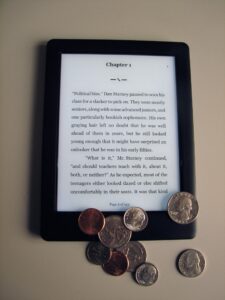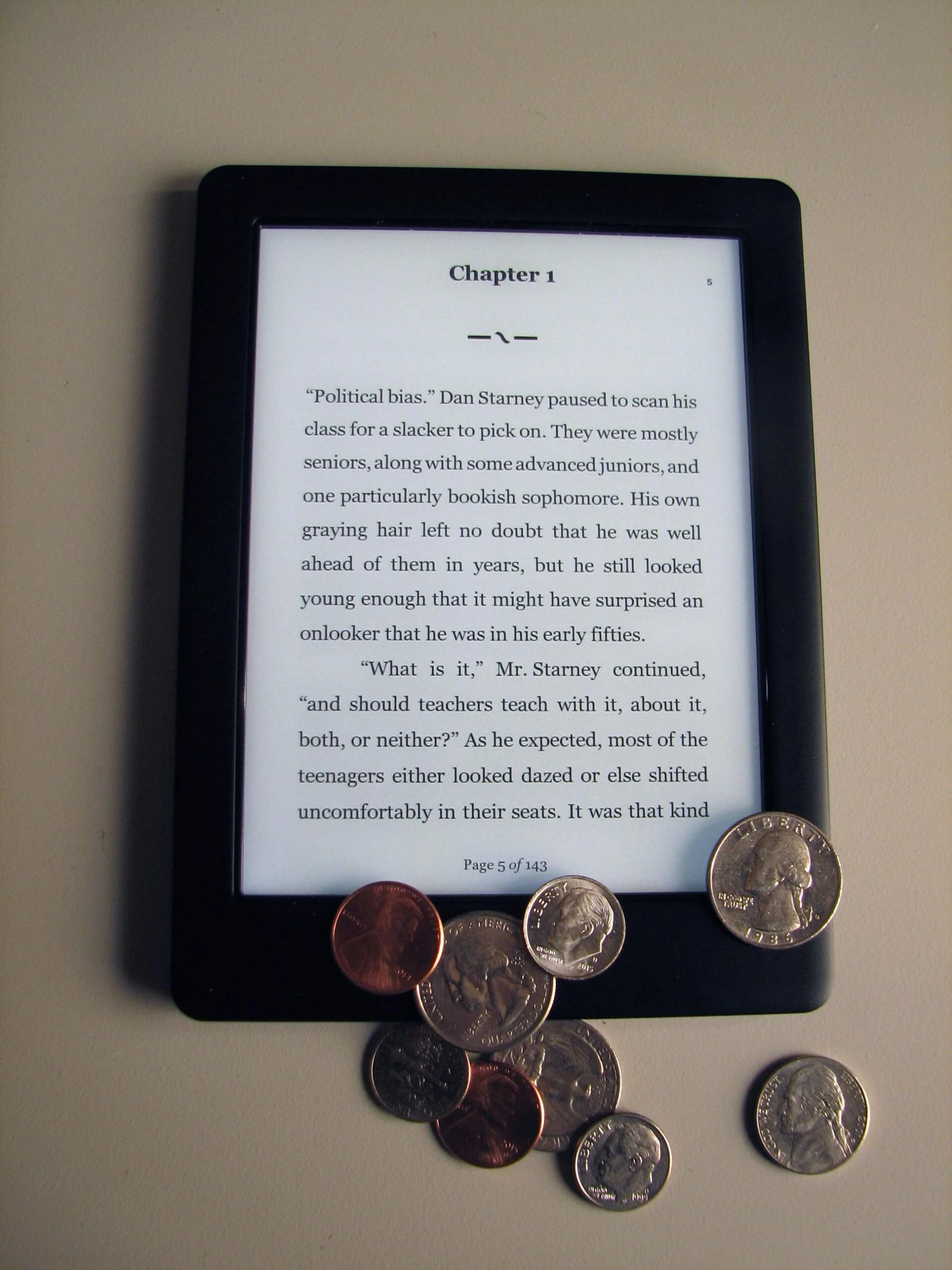
How do you price your ebooks?
Many self-publishing authors often wonder how to price their ebooks, especially when they're launching their first one. Round pounds/dollars/Euros or something-point-99? Or should it be something-point-95 for Euros, because 1c coins are getting increasingly rare, as their value is so small?
Established authors of multiple authors also wonder whether, when and how often to change their prices – and whether to put them up or down.
While there are no absolute rights or wrongs in setting price points, one of the advantages of being indie is that you can choose your own prices, and change them as often as you think fit, till you hit that sweet spot where your ebooks are flying off the virtual shelves. And it may not always be the price you expected. Nor will the price that looks as it might be more profitable make you the most money e.g. in some cases you may sell more books priced in the .99-$2.98 bracket that earns you 35% of the sale price than if you price them in the $2.99-$9.99 bracket entitled to a 70% royalty. Or you may not. It's down to you to decide, experimenting with different prices if necessary along the way.
Here are twelve thoughts to help you decide how to set your ebook's prices.
- Flexibility You have much more flexibility with ebooks than with print, because your fixed costs of publishing them are much lower.
- Territory The price you see on Amazon may not be what will show up to residents of other territories. When I view my 99p/99c books from the UK on the US .com site, they appear to cost $1.47. Since I learned that to US viewers it will show up as 99c, I no longer panic at that sight.
- Taxes Different taxes are automatically applied in different countries. Not only does KDP include these for you, it also updates your prices as tax laws change, e.g. when VAT recently became applicable to ebooks in Europe. Overnight, our 77p books (previous minimum price) became 99p books. (To be fair to Amazon, they did give us ample advance notice of the change, even though we could do nothing about it. The law is the law, and not even Amazon can change the law.)
- Profitability The appropriate price varies by genre and by book and by the status of the author. Ultimately, the right price is what the optimum number of customers are prepared to pay. You may make more profit by selling lots of 99p books than pricing your ebook high and selling far fewer copies. If unsure, find authors in your genre who have a similar stature and output to you, and start by emulating what they do.
- Differences Trade-published ebooks tend to be priced much higher than self-published ebooks for two main reasons: (a) the author has an established reputation and so can command higher prices (b) many trade publishers haven't quite embraced the flexibility that indie authors tend to have around their pricing policies.
- Trade practice A lot of trade-published ebooks are priced puzzlingly high, compared to the print books. Sometimes I wonder whether the publisher simply doesn't want to sell ebooks, preferring to stick in their comfort zone of print. Don't assume that you should do the same in order to look more professional.
- Familiarity Whatever prices you're charging, keep them neat and recognisable as standard prices, otherwise you risk distracting people from clicking the “buy now” button. Think about your shopping experience in other retailing sectors. Wouldn't you pause for thought if the price of a new sweater was £23.47 rather than £23.99 or £22.99? Or if you're offered 6/11ths of a pint of beer rather than a pint or a half? It may seem daft, but the fewer obstacles you put between the potential buyer and the moment of purchase, the better.
- Country comparisons You don't have to accept the equivalent price for countries all over the world, based on the US dollar price that is typically the first one to be designated in the dashboard of distributors such as KDP and Draft2Digital. I always neaten my prices to .99 of any currencies that are decimal, rounding down rather than up if that's a closer price match, even though it means Canadian and Australian sales will be worth slightly less to me than US sales.
- Favouritism If you're trying to boost sales in a particular territory, you might want to offer them a much lower price than elsewhere, at least temporarily, for a country-specific promotion.
- Ringing the changes Once you've set your price for an ebook, provided you have published it yourself, rather than through a service provider, you can change it as often or as much as you like, until sales start to take off and/or profits optimise. Consider launching at a low price to notch up significant sales, before cranking it higher till sales stop. Then crank it back down again quick to restart them!
- Series pricing If you have a series of books, it's worth pricing the first in a series low to lure in more readers. You'll recoup more profit when they go on to buy subsequent books in the series at higher prices.
- Entry-level pricing If you can't justify pricing one of your full-length ebooks at a low-risk “why not try it?” price, consider publishing something that you're happy to sell at that price – a novella instead of a novel, or a single short story that stands alone instead of a collection. Just be sure to make it very clear on your blurb what the reader is getting for their money, so you don't get disgruntled reviews. You may still get them – there are plenty about saying “I didn't like this because it's a short story and I only like novels”, but if your single short story is clearly labelled as such, other readers will disregard such negative comments as foolish, and quite rightly so.

Taking care of the pennies?
Why .99?
Finally, it's fun to consider why that .99 ending has become the most popular price format, when round dollars, pounds or Euros are so much neater and easier to understand.

Ker-ching!
There is a story that such price points were set hen the first mechanical tills were invented, ensuring shop assistants had to ring up every sale and open the cash drawer to give a penny change, making it less tempting to pocket whole dollars/pounds. Surely that has to be an urban myth, because it wouldn't take a smart sales assistant long to work around that necessity by keeping a pocket full of pennies at all times.
US novelist John Doppler provides a more convincing explanation:
The .99 pricing is a principle firmly grounded in psychology. Because we read from left to right, the first digit has the strongest impact on us. Even though it's only a penny's difference, buyers are more likely to purchase an item for $3.99 than they are $4.00. $9.99 sells better than $10.00. We're also conditioned to associate prices ending in “9” with sales prices or bargains. One study found that raising prices from $24 to $29 led to a dramatic increase in sales, and lowering a price from $29 to $24 led to a decrease in sales. Changing the price from $24 to $34 had no effect. so deviating from that practice could cost you sales.
OVER TO YOU What's your favourite pricing practice? We'd love to know!
Top tips on pricing #selfpub #ebooks from @DebbieYoungBN & @JohnDoppler Share on XRELATED POSTS
- 5 Top tips for Formatting Ebooks by Derek Murphy
- Why Now's a Good Time to Publish Serial Fiction by Samantha Warren
- How to Raise Awareness by Cutting the Price of the First Book in a Series by Alison Morton





[…] book must be "priced well in such a way that it gives more profit." For more tips on pricing, see this article by the Alliance of Independent […]
[…] Publishing Advice: 12 Top Tips on Setting Ebook Prices […]
[…] 12 Top Tips on Setting Ebook Prices – by Debbie Young […]
[…] How to price an e-book: https://selfpublishingadvice.org/12-top-tips-for-setting-ebook-prices/ […]
[…] Price setting is never easy, but with digital products it can be even more confusing. Here are 12 top tips for setting ebook prices. […]
Thank you for the article. I’ll be trying this with my book as I’ll be running more promotions in the future. Usually when I see odd priced books I can tell they are from a different territory. I don’t think I would not buy it for that reason, but then again, I’m an author and more lenient to those oversights.
[…] Debbie Young Many self-publishing authors often wonder how to price their ebooks, especially when they’re […]
Interesting and useful article. Thank you. I entirely agree about pricing books at x.99, although I recently changed one of my book prices from 99p to £1.99 on Amazon UK but it shows up on the sales page as £1,91.
The psychology of the .99 price is one key reason why we should always take the time – be it in KDP, KWL, D2D or whatever – to set the price for each country/territory, where we have that option.
Just setting the default price at .99 USD and allowing the territorial prices to be completed automatically means we lose that psychological advantage because or 2.99 USD price will be 3.47 or 4.28 or some other unattractive value in another country.
Absolutely, Mark – and I always take pleasure in tidying the prices to look psychologically pleasing in all the currencies on offer.
Debbie,
Another timely and helpful post from you. I’ve been struggling with pricing issues lately, and although I’ve been publishing books with KDP since 2012, even I didn’t think that I could set all the territories at the price that suits me. Doh!
And that little note on the 99 cent price looking as if it’s something quite different when browsing on the US site from the UK and elsewhere is invaluable. I haven’t been laying awake about this, but because The Englishman is on a 99 cent promo until end of January, it’s something I’ve been meaning to query with Amazon. You’ve saved me that too.
Thank you.
So glad it helped you, Helena. There are so many pieces in this big self-publishing jigsaw, it’s very easy to miss some along the way!